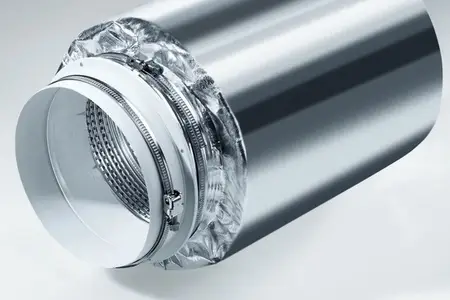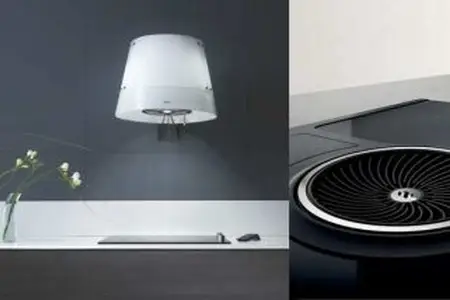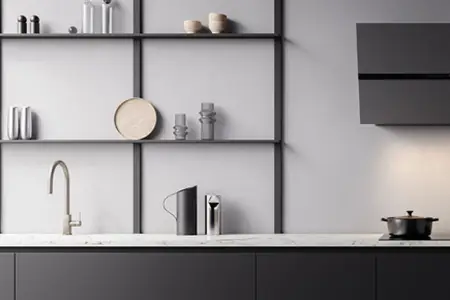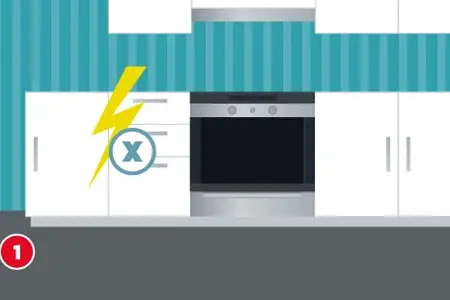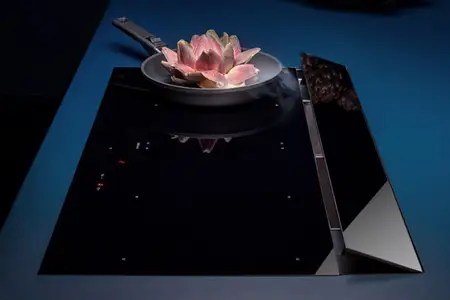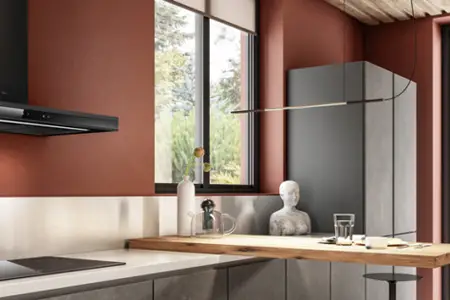A range hood is an almost indispensable element in every well-equipped kitchen that improves air quality, effectively eliminates unwanted vapors and odors, thus contributing to a more pleasant cooking experience. While many range hoods are equipped with an exhaust system that directs contaminated air outside, there is an intelligent alternative for kitchens where installing an exhaust duct is not possible. This solution is range hoods without air exhaust. In this article, we will thoroughly examine these innovative devices and how they can effectively clean the air in your kitchen.
Range Hoods: An Asset in Every Kitchen
The range hood is undoubtedly an essential component of every kitchen. It takes on the task of eliminating vapors, odors, and grease that arise during cooking. Besides improving air quality, it also helps protect kitchen furniture and surfaces from annoying deposits. A high-quality range hood can even protect walls and ceilings from the negative effects of prolonged exposure to steam and grease.
Range Hood without Air Exhaust: The Solution for Kitchens without Exhaust Ducts
However, there are situations where an exhaust system is not available or installing an exhaust duct simply seems impossible. In such cases, range hoods without air exhaust come into play. These innovative devices offer an alternative solution by recycling the air in the kitchen. They draw in the air, filter it, and release it back into the room cleaned. This way, you can enjoy the benefits of a range hood regardless of the availability of an exhaust system.
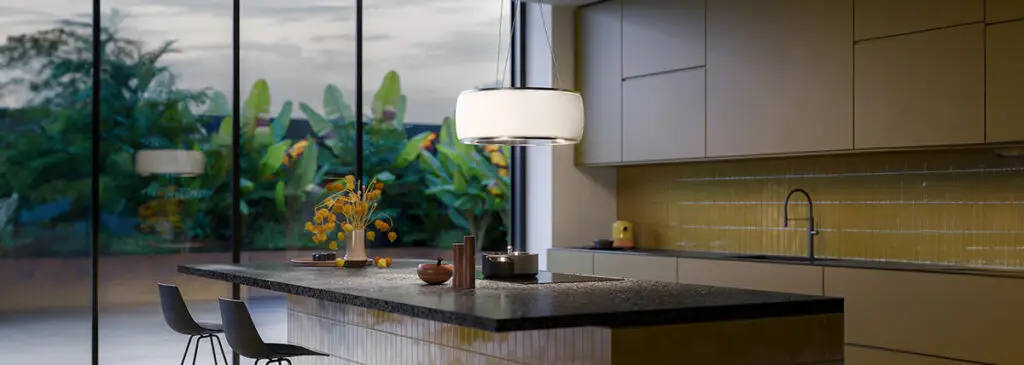
The Different Types of Range Hoods without Air Exhaust: The Right Choice for Your Kitchen
The variety of range hoods without air exhaust makes it possible to select the most suitable model for individual needs and kitchen configuration. Here are some of the most common types that can help you choose the ideal model:
Recirculating: Efficient Air Cleaning without Exhaust Duct
The recirculating hood is one of the most popular options for kitchens without an exhaust system. It works by drawing in air, passing it through activated carbon filters, and then releasing it back into the room cleaned. This is an extremely effective method for eliminating vapors and odors. Activated carbon filters are particularly effective at neutralizing odors as they absorb odor particles, thus providing noticeable odor elimination.
The advantage of a recirculating hood lies in its simple installation and independence from exhaust ducts. This allows for flexible placement in the kitchen without having to consider structural changes. It is particularly well-suited for rental apartments or kitchens where installing an exhaust system is not possible or desired.
Ceiling Hood: Space-Saving Elegance for Modern Kitchens
Ceiling hoods are aesthetically pleasing options that seamlessly integrate into modern kitchen designs. They are installed directly into the ceiling and are particularly suitable when kitchen space is limited. These range hoods without air exhaust not only offer powerful air cleaning but are also extremely unobtrusive.
Through their integration into the ceiling, they are barely visible and give the kitchen a modern and elegant appearance. Since they are placed directly above the cooking area, they capture rising vapors extremely efficiently. Ceiling hoods are the perfect choice if you’re looking for a space-saving and stylish solution that is also powerful.
Both the ceiling hood and the following under-cabinet hood are available in both recirculating and exhaust operation modes.
Under-Cabinet Hood: Space-Saving and Effective
Under-cabinet hoods are another space-saving option for kitchens without an exhaust system. They are installed under a wall cabinet and take up very little space. Despite their compact size, they represent an efficient solution for extracting vapors and odors and keeping the air in the kitchen fresh.
These range hoods are particularly suitable when you have limited space available in your kitchen. They are easy to install and still provide effective air cleaning. Since they are mounted under a wall cabinet, they don’t disturb the overall appearance of your kitchen and seamlessly integrate into the existing furnishings.
The choice of the right type of range hood without air exhaust depends on your individual requirements and the configuration of your kitchen. Whether you prefer the efficiency of a recirculating hood, the elegance of a ceiling hood, or the space savings of an under-cabinet hood, there is a wide range of options to improve the air quality in your kitchen. With these various types of range hoods without air exhaust, you have the opportunity to find the perfect model for your kitchen that is both functional and aesthetically pleasing.
The Difference Between Exhaust and Recirculation
Before we delve further into range hoods without air exhaust, it’s important to understand how exhaust and recirculation systems differ from each other.
Exhaust System: The Classic Solution
The conventional range hood with exhaust directs contaminated air outside through an exhaust duct. This is undoubtedly the most effective method for removing vapors and odors from the kitchen. However, installing an exhaust system usually requires structural changes and is not feasible in all kitchens.
Recirculation System: The Alternative without Exhaust Duct
Range hoods without air exhaust work in recirculation mode. They draw in the air, filter it, and release it back into the room. This enables simple installation without extensive renovations. However, it should be noted that the filters must be changed at regular intervals.
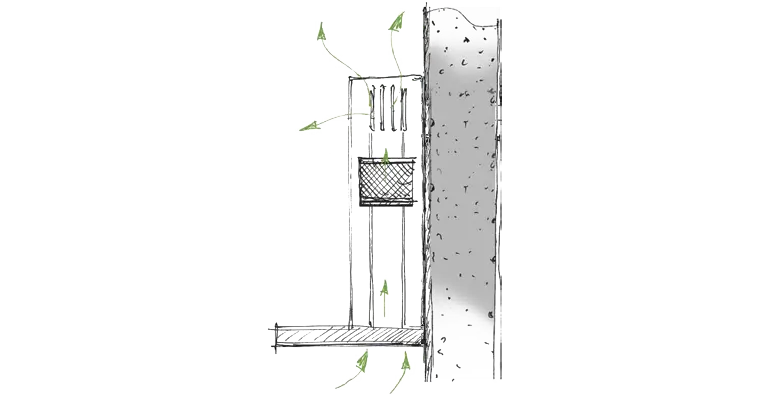
The Advantages of Ductless Range Hoods
Ductless range hoods offer various benefits that make them an extremely attractive option for many kitchens.
Flexibility in Placement: Unlimited Possibilities for Your Kitchen with Ductless Range Hoods
A major advantage of ductless range hoods is their remarkable flexibility in placement. Since they don’t require ductwork, you can install these devices almost anywhere in your kitchen. This freedom opens up a world of possibilities when designing your kitchen. Whether you have an open kitchen, a cooking island, or a classic kitchen layout, the ductless range hood can be easily integrated into any scenario.
A popular choice is installing it above a cooktop, which allows effective extraction of steam and odors directly at the source. Other locations, such as near the oven or above a cooking island, are also easily possible. The only requirement is having a power outlet nearby to supply electricity to the range hood. This flexibility allows you to customize your kitchen design according to your individual preferences without worrying about duct placement.
Easy Installation: Time and Cost-Saving
Installing a ductless range hood is typically very straightforward and doesn’t require extensive construction work. Unlike setting up a ducted system, which often requires extensive renovations, you can have a ductless range hood ready to use in no time.
This simple installation saves both time and money. You don’t need professional contractors to mount the device. With the provided instructions and some basic DIY skills, you can easily complete the installation yourself. This means you can save significantly not only on the purchase of the range hood but also on installation costs.
Energy Efficiency: Environmentally Friendly and Cost-Effective
Modern ductless range hoods are typically characterized by their impressive energy efficiency. Compared to older models, they are extremely economical in energy consumption. This is not only good for the environment but also for your wallet.
Through lower energy consumption, you help reduce CO2 emissions and lower your energy costs. Modern technologies like energy-efficient motors and LED lighting help ensure that the ductless range hood effectively cleans the air in your kitchen without driving up your electricity bill.
Effective Air Purification: Fresh Air in Your Kitchen
Despite lacking a duct system, ductless range hoods provide highly effective air purification. These devices are equipped with powerful filters that efficiently remove steam and odors.
The filters, especially activated carbon filters, play a crucial role here. They can absorb odor particles contained in the steam, ensuring noticeable odor elimination. At the same time, they trap grease and dirt particles, keeping your kitchen cleaner longer. This not only leads to pleasant and fresh air in your kitchen but also increases hygiene and durability of your kitchen fixtures.
Stylish Design: aesthetics and Functionality
Besides practical advantages, ductless range hoods often offer aesthetically pleasing designs. Many manufacturers emphasize combining aesthetics with functionality, making these devices stylish elements in your kitchen.
The selection ranges from modern and minimalist designs to timeless classics. A ductless range hood can not only fulfill its main function but also serve as a stylish decorative element. They seamlessly integrate into your kitchen’s overall appearance and add a touch of elegance and modernity. This allows you to make the range hood a central element in your kitchen design that meets both your aesthetic and functional requirements.

Practical Changes for Effective Use: How to Maximize Your Ductless Range Hood’s Performance
Choosing a high-quality ductless range hood is the first step in improving your kitchen’s air quality. However, there are several practical changes and tips you should consider to maximize this device’s effectiveness.
Proper Placement: Effective Extraction
Proper placement of your range hood is crucial for ensuring effective extraction of rising steam and odors. Ideally, the hood should be installed directly above the cooktop. This ensures it captures emerging steam before it spreads throughout the kitchen. Consider the recommended installation height, typically specified in the device’s manual. Correct placement ensures the range hood performs its task optimally.
Regular Cleaning: Maintaining Performance
Regular cleaning of your range hood is crucial for maintaining optimal performance. This particularly involves maintaining filters and collection trays. The filters in ductless range hoods are responsible for catching grease and dirt particles and cleaning the air. Depending on how often you cook, you should regularly remove and clean or replace the filters as needed. This ensures the hood continues to work effectively and keeps your kitchen air fresh. The user manual provides guidance on how best to perform cleaning.
Proper Suction Power Settings: Adjusting to Needs
Your range hood’s suction power can be adjusted according to cooking intensity. On low settings, the hood is quieter and suitable for light cooking. However, when generating stronger steam and odors, such as when frying, you can increase the suction power. This cleans the air more effectively and eliminates unwanted odors faster. Variable suction power allows you to adapt the range hood to your current needs while controlling noise levels in the kitchen.
Fresh Air Supply: Creating optimal Conditions
To allow the ductless range hood to work effectively, it’s important to ensure adequate fresh air supply in your kitchen. This can be achieved by opening a window or operating a ventilation system. A constant supply of fresh air ensures that extracted air is efficiently replaced, allowing the range hood to perform its task better. Additionally, this noticeably improves air quality in your kitchen.
By considering these practical changes and tips, you can maximize your ductless range hood’s performance. Correct placement, regular cleaning, adjusting suction power, and ensuring adequate fresh air supply all contribute to maintaining a pleasant and odor-free kitchen environment. With these measures, your range hood stays in top form and makes a valuable contribution to improving your kitchen’s air quality.
Conclusion: Ductless Range Hood for Fresh Air in Your Kitchen
A ductless range hood is undoubtedly the ideal solution for kitchens without the possibility of installing a ventilation system. They offer effective air purification, flexibility in placement, and stylish design. With the right practical modifications and selection of the appropriate model, you can significantly improve the air quality in your kitchen. Invest in a high-quality ductless range hood to transform your cooking experiences into pleasant, odor-free time in your kitchen. Your kitchen space will thank you!
Frequently Asked Questions (FAQ) about Ductless Range Hoods
Question: What is a ductless range hood?
Answer: A ductless range hood is a device designed to improve air quality in your kitchen by effectively removing cooking vapors and odors. Unlike conventional ducted range hoods that channel contaminated air outside, ductless range hoods recycle the air in the kitchen. They draw in air, filter it, and return it cleaned to the room, allowing for flexible placement in the kitchen.
Question: What types of ductless range hoods are there?
Answer: There are various types of ductless range hoods, including recirculating hoods. The recirculating hood works by drawing in air, passing it through activated carbon filters, and then returning it cleaned to the room. This effective method of removing steam and cooking vapors is particularly effective at neutralizing odors as the activated carbon filters absorb odor particles.
Question: What are the advantages of a ductless range hood?
Answer: Ductless range hoods offer numerous advantages, including flexibility in placement, easy installation, energy efficiency, and effective air purification. They contribute to improving air quality in your kitchen and are available in stylish designs. By comparing different models, you can select the ductless range hood best suited to your needs.
Question: How can you maximize the performance of a ductless range hood?
Answer: To maximize the performance of your ductless range hood, ensure proper placement, perform regular cleaning, and adjust the suction power. Also pay attention to fresh air supply in your kitchen to create optimal conditions.
Question: What is the difference between ducted and ductless systems in range hoods?
Answer: Ducted systems channel contaminated air outside through a vent pipe, while ductless systems, used in ductless range hoods, draw in air, filter it, and return it cleaned to the room. The choice between these systems depends on your kitchen’s structural conditions.
Question: What role does the extractor play in a ductless range hood?
Answer: The extractor, also known as the hood, is the central element of the range hood. It draws vapors and cooking fumes into the hood, where they are cleaned and then returned to the kitchen. This improves air quality.
Question: Are there special considerations for installation in an intermediate shelf?
Answer: Installation in an intermediate shelf requires special attention. You should ensure that the shelf can safely support the hood and that there is sufficient space for air circulation. The hood should be correctly and stably installed.
Question: How does the ductless range hood affect the air in your kitchen?
Answer: The ductless range hood improves air quality in your kitchen by effectively removing vapors and odors. This creates a pleasant cooking environment and protects your kitchen furniture from deposits.
Question: Can the ductless range hood be installed in rental apartments?
Answer: Yes, the ductless range hood is particularly suitable for rental apartments as it requires no structural changes. It can be flexibly placed in the kitchen without making permanent alterations to the building structure.
Question: How often should the filters of a ductless range hood be changed?
Answer: The filters of the ductless range hood should be changed regularly depending on usage intensity and manufacturer recommendations. This ensures that the hood maintains its optimal performance and continues to effectively clean the air in your kitchen.

